Magnetic and non-magnetic materials
- Books Name
- Class 6 Science Book
- Publication
- PathSet Publications
- Course
- CBSE Class 6
- Subject
- Science
Introduction
Discovery Of Magnets
According to a legend, the first magnet was discovered by a Greek shepherd named Magnes. It is said that the nails in his shoes and the iron tip of his staff got stuck to a large black rock on which he was standing. Greeks named this strange type of rock ‘magnetite’. The Chinese also knew about magnets. Ancient Chinese sailors used magnets for navigation.
Magnets
Magnets are made of materials that attract objects made of certain substances like iron, cobalt, and nickel.
Magnets come in various shapes and sizes (Fig. 12.1). They can be found as horseshoe, ring, cylindrical, or bar shape.
Not all objects are attracted to magnets. Objects that are attracted by a magnet are said to be magnetic, e.g., iron and nickel. Objects that are not attracted by a magnet, are said to be non-magnetic, e.g., wood and plastic.
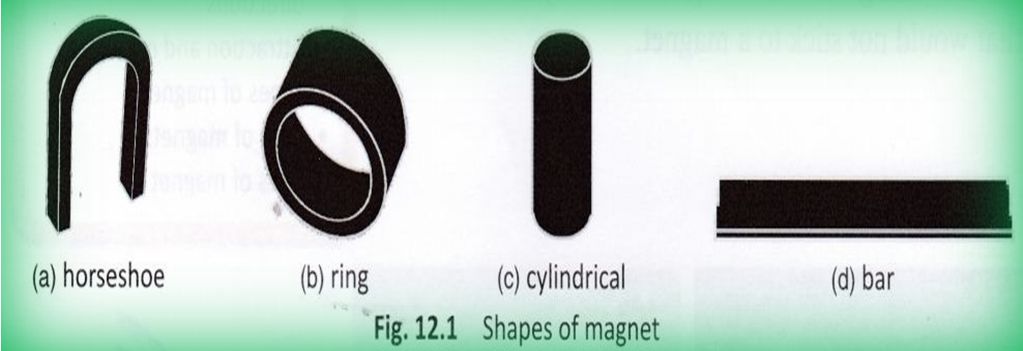
What are Magnets?
Magnets are pieces of iron or other materials which exhibit the properties of magnetism i.e. the ability to attract other objects that contain iron. Compass needles, fridge magnets and MRI scanners are some common examples of magnets.
It is said that magnets were discovered after a shepherd named Magnes accidentally got his iron stick stuck to a rock. It was later discovered that the said rock had magnetic properties and was called Magnetite, named so after the shepherd.
These days magnets come in different shapes and forms such as: horseshoe magnet, bar magnet, cylindrical or a ball-ended magnet, needle magnet etc.
Natural Magnet: Magnetite is called natural magnet.
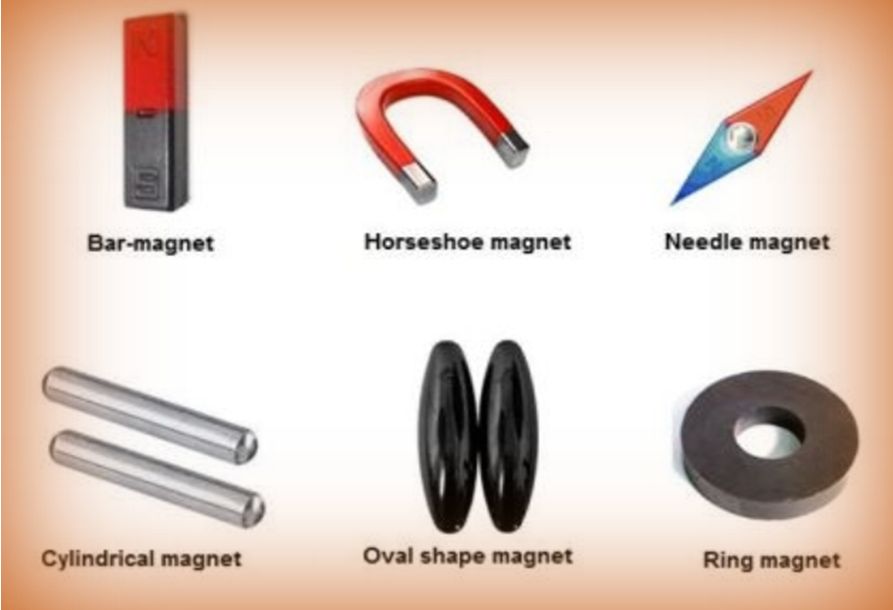
Magnetic and Non-Magnetic Materials
Magnetic Materials: Materials like nickel, cobalt and iron are called magnetic materials. These materials are attracted to magnets.
Non-Magnetic Materials: Materials like rubber, plastic, cloth, glasses etc. which are not attracted to magnets are referred to as non-magnetic materials.
Types Of Magnets
There are two types of magnets: temporary and permanent. Magnets that retain their magnetic properties only for a short period of time are called temporary magnets. Magnets that retain their magnetic properties for a long period of time are called permanent magnets.
Temporary magnets are usually made of iron, cobalt, or nickel. These materials behave like magnets only when they are near a strong magnet. They quickly lose their magnetic property if the influence of the strong magnet is removed.
Permanent magnets are made from mixtures of iron, cobalt, or nickel with other materials. These make strong magnets and retain their magnetic properties for a long time.
Uses Of Magnets
Magnets have several uses:
- Credit cards, ATM cards, and identity cards have a strip of magnetic material that stores information.
- Television and computer monitors use magnets.
- Computer hard discs and audio and video cassettes have magnetic material that store information.
- Magnets are used in picking up substances made of iron from scrapyard.
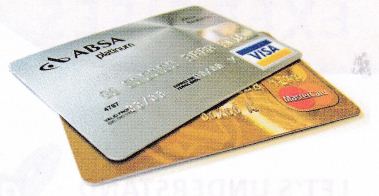
Poles of magnet
- Books Name
- Class 6 Science Book
- Publication
- PathSet Publications
- Course
- CBSE Class 6
- Subject
- Science
Poles of Magnet
We can observe a very interesting property about magnets which is that when we try to attract iron filings or any other magnetic objects to a magnet, they always accumulate at the ends of the magnet.
This is because near the poles the magnetic field of the magnet is very strong.
A Magnetic field is defined as the region around a magnet within which the magnetic force acts. Being strongest at the poles, this is why magnetic objects get attracted to the ends of the magnet.
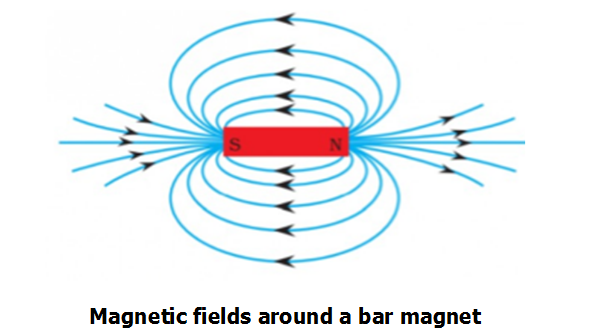
Finding directions
- Books Name
- Class 6 Science Book
- Publication
- PathSet Publications
- Course
- CBSE Class 6
- Subject
- Science
Finding Directions
Another great property of a magnet is that it can prove extremely helpful in navigating directions. This is because a freely suspended magnet always points in the North-South direction.
This property of magnet is used to make a compass. A magnetic needle is placed inside a box with directions marked on it. It is allowed to rotate freely so that when the compass is kept at the position of rest, the needle points towards the north and south direction.
Make your own magnet
- Books Name
- Class 6 Science Book
- Publication
- PathSet Publications
- Course
- CBSE Class 6
- Subject
- Science
Make your own Magnet
Steps to make own Magnet
- Take a rectangular piece of iron. Place it on the table.
- Take a bar magnet and place one of its poles near one edge of the bar of iron. Without lifting the bar magnet, move it along the length of the iron bar till it reaches the other end.
- Lift the magnet and bring the pole (the same pole we started with) to the same point of the iron bar from which we began. Move the magnet again along the iron bar in the same direction as we did before.
- Repeat this process about 30-40 times. The iron piece has become bar magnet.
Attraction and repulsion between magnets
- Books Name
- Class 6 Science Book
- Publication
- PathSet Publications
- Course
- CBSE Class 6
- Subject
- Science
Attraction and repulsion between Magnets
Attraction And Repulsion
When two magnets are brought close to each other, they are either pulled towards each other, or pushed away from each other. When the magnets are pulled towards each other, they are said to attract each other. When they are pushed away from each other, they are said to repel each other. Whether the magnets attract or repel depends on which poles of the magnets are facing each other.
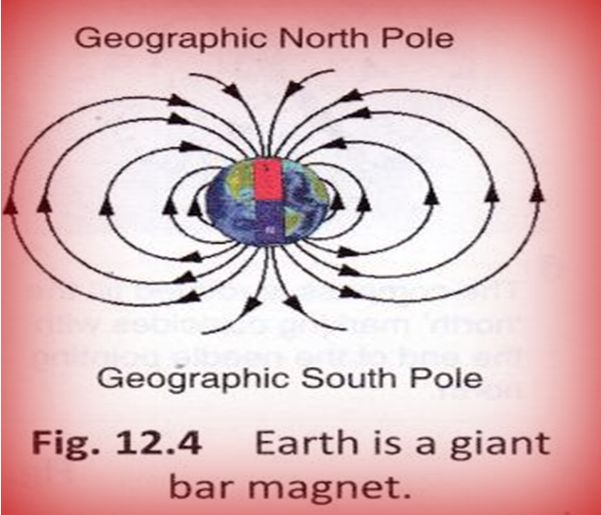
Attraction and Repulsion among Magnets
- Opposite or unlike poles i.e. North and the South Pole attract each and vice versa.
- Similar or like poles like north and north poles of two magnets repel each other. Same is the case with South poles of two magnets.
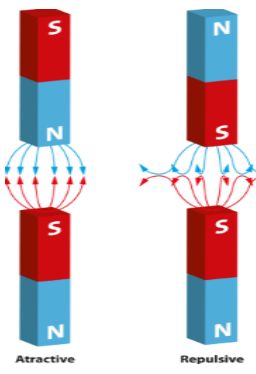
Attraction between opposite poles and repulsion between similar poles
When like poles of the magnets (N-N or S-S) are brought close to each other, they repel. This is called repulsion.
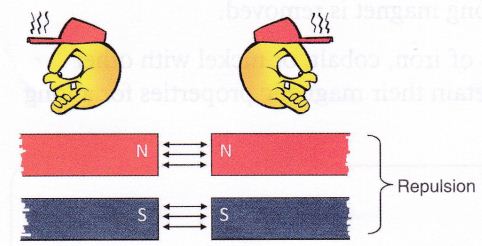
When unlike poles of the magnets (N-S or S-N) are brought close to each other, they attract. This is called attraction.
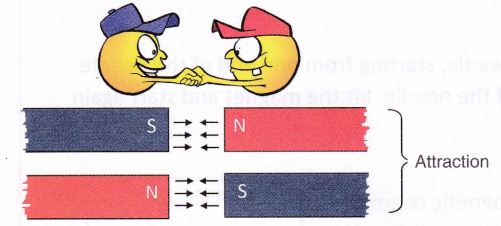
Notes of caution
- When heated, hammered or dropped from a height, magnets tend to lose their properties.
- They become weak if they are not stored properly and hence:
- Bar magnets should be stored in pairs separated by a small block of wood and their unlike poles facing the same side with a soft iron across their ends.
- A piece of iron should be kept across the poles in case of a horseshoe magnet.
- should be kept away from computers, mobiles, televisions etc.
- Magnets should be handled with care and they should be stored properly.
Care Of Magnets
A magnet can lose its properties due to the following activities.
- Dropping from a height
- Hitting with a hammer
- Applying heat
- Improper storage can also cause loss of magnetic properties.
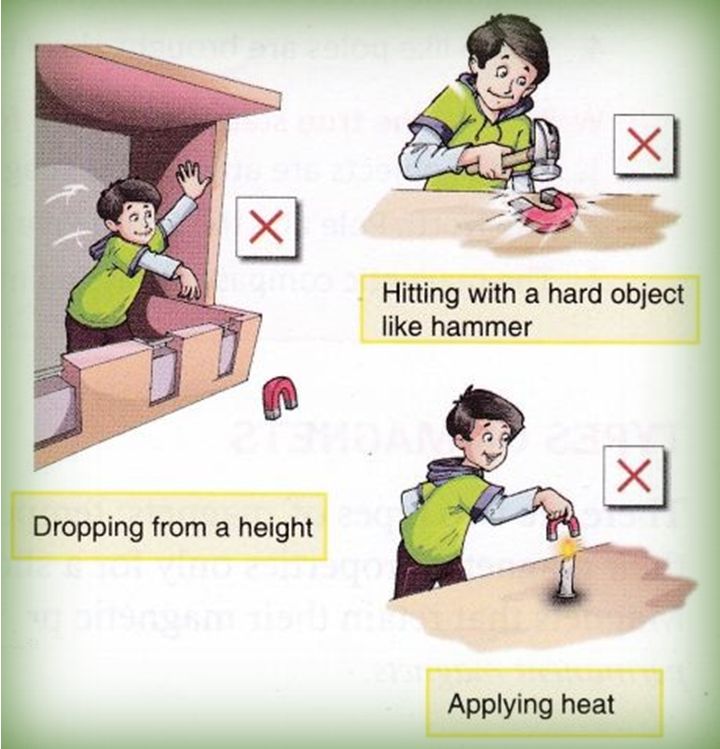
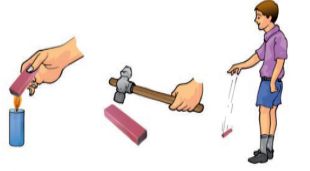
Bar magnets should be stored in pairs, with Dropping from a height unlike poles alongside each other. A horseshoe magnet should be stored with a piece of soft iron kept across its poles.
SUMMARY
Uses of a Magnet: A magnet finds its use at a number of places. For example, refrigerator’s door, some pencil boxes, many toys, magnetic stickers, soap stand, pin stand, all make use of a magnet for their functioning.
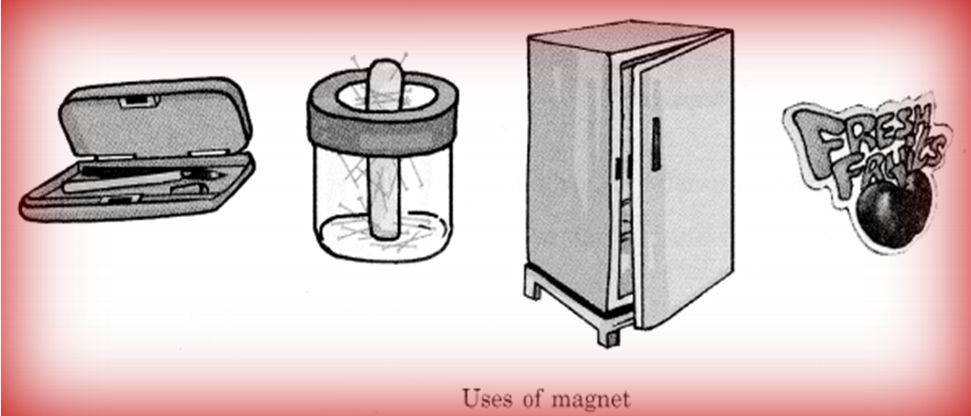
Shapes of Magnets: Magnets are made of different materials and in different shapes.

Effect of a magnet on materials: A magnet attracts certain materials, whereas some do not get attracted towards magnet.
Magnetic materials: The materials which get attracted towards the magnet are known as magnetic materials, e.g., iron, nickel, cobalt.
Non-magnetic materials: The materials which are not attracted towards the magnet are known as non-magnetic materials, e.g., leather, plastic, cloth, paper. Magnetic poles: Magnetic attraction is maximum near the ends of the magnet. These ends are called magnetic poles.

When suspended freely, magnet always aligns in north-south (N-S) direction.
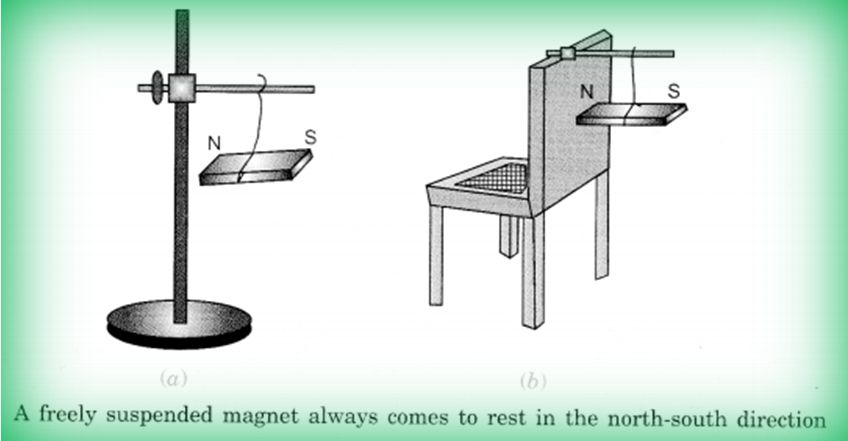
Lode stone: It was a stone used by sailors in olden days to identify directions when they were in sea.
Compass: This is a small glass case containing a magnetised needle pivoted on a nail. The needle can rotate freely. Wherever it is kept, its needle always rests in north-south direction. Normally the north-pole of the needle is painted red or some other indication is given to identify north and south-poles. So using this needle, north and south can be identified.
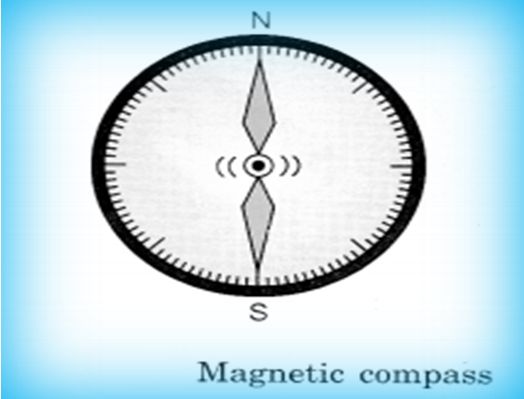
Attraction between two poles: Opposite poles of two magnets attract each other. It is called attraction.
Repulsion between two poles: Similar poles of two magnets repel each other. It is called repulsion.
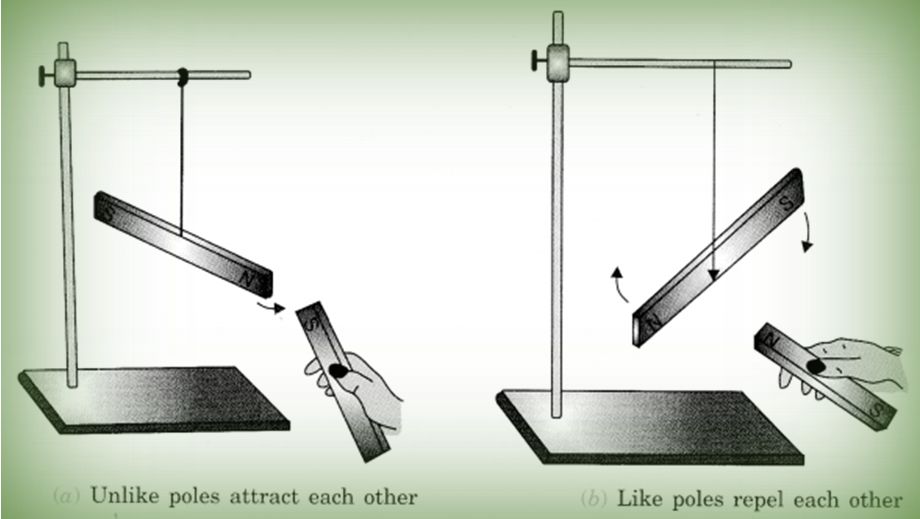
Magnetic effect can pass through screen: Magnetic influence can pass through screens of some substances like cloth, plastic, paper, glass, etc.
Magnets lose their properties if they are heated, hammered or dropped strongly and hardly.
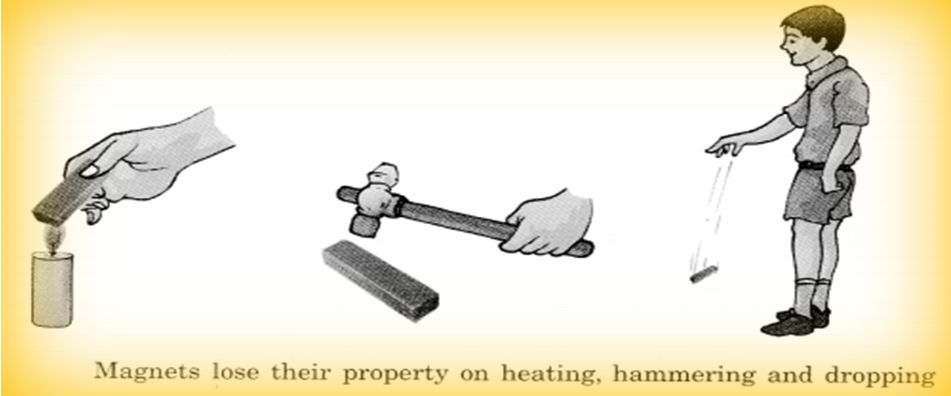
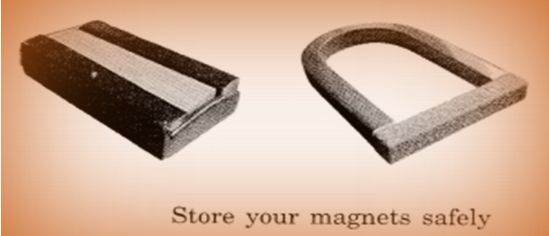
To keep them safe, bar magnets should be kept in pairs with their unlike poles on the same side. They must be separated by a piece of wood while two pieces of soft iron should be placed across their ends. For horse-shoe magnet, we should keep a piece of iron across the poles.

 Param Publication
Param Publication
 PathSet Publications
PathSet Publications
